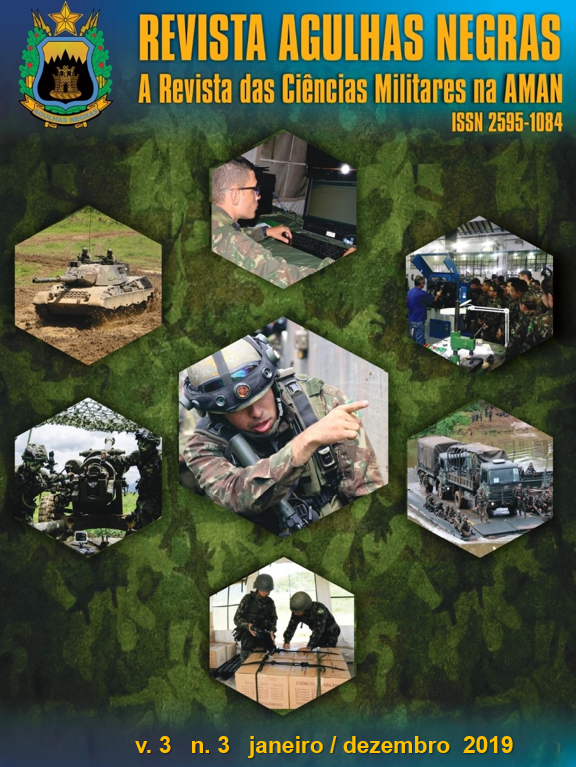A PROVA DE 400 METROS RASOS NA FORMAÇÃO DA AMAN
A EVOLUÇÃO DO DESEMPENHO DOS CADETES DO 2° ANO DE 2009 A
Resumo
Este artigo visa analisar os índices obtidos na prova de 400 metros rasos por uma geração de militares
(4.429 indivíduos, saudáveis, com idade 20 a 23 anos) que compuseram o segundo ano do Curso de
Formação de Oficiais da Academia Militar das Agulhas Negras (AMAN) de 2009 a 2018, verificando
estatisticamente as notas obtidas durante o teste físico. Para realizar esta análise foi utilizado o
software BioEstat 5.0 e os dados foram coletados na Seção de Educação Física da AMAN. Os
resultados do teste Kolmogorov – Smirnof apontaram que as notas de nenhuma das turmas respeitaram
a uma normalidade estatística. O teste de Mann-Whitney indicou que não houve diferenças
significativas entre as notas das turmas de 2009 e 2010; 2010 e 2011; 2011 e 2012; 2012 e 2013; 2013
e 2014; 2014 e 2015; 2016 e 2017. O mesmo teste indicou que há diferenças significativas entre as
notas das turmas de 2015 e 2016 e entre a turma de 2017 e 2018. Houve uma diminuição significativa
de 2015 para 2016 e um aumento considerável da média em 2018 em relaç
Downloads
Referências
ALMEIDA, Patrícia Alves de; PIRES, Cássio Mascarenhas Robert. A importância do treinamento intervalado em
programas de redução de peso e melhoria da composição corporal. Revista Digital. Buenos Aires. Ano, 2008, vol. 13.
BRASIL, Estado-Maior do Exército. EB20-MC-10.350 Manual de Campanha C 20-20–Treinamento Físico Militar. 4ª
edição. 2015.
CHIAVENATO, Idalberto. Introdução à teoria geral da administração. Elsevier Brasil, 2003.
CHIAVENATO, Idalberto; SAPIRO, Arao.Planeación estratégica. McGraw-Hill Interamericana, 2017.
DANTAS, Estélio HM. A prática da preparação física. Em A prática da preparação física. 6ªed. – Vila Mariana, SP:
Roca 2014.
DE PAULA, Augusto César Fernandes; ALONSO, Denise de Oliveira. Treinamento intervalado no treinamento aeróbio
ou anaeróbio interval training in the aerobic or anaerobic training. Revista de Atenção à Saúde (antiga Rev. Bras.
Ciên. Saúde), 2010, vol. 6, no 15.
DELGADO FLOODY, Pedro, et al. Niveles de obesidad, glicemia en ayuno y condición física en escolares chilenos.
Nutrición Hospitalaria, 2015, vol. 31, no 6, p. 2445-2450.
DEMINICE, Rafael, et al. Série de treinamento intervalado de alta intensidade como índice de determinação da
tolerância à acidose na predição da performance anaeróbia de natação. Revista Brasileira de Medicina do Esporte,
, vol. 13, no 3, p. 185-189.
Exército Brasileiro. SEPARATA AO BOLETIM DO EXÉRCITO Nr 23 - Aprova o padrão especial de desempenho
físico para os Cursos De Formação de Oficiais. Boletim do Exército nº 23, de 8 de junho de 2018
FRANCHINI, Emerson; DEL VECCHIO, Fabrício Boscolo. Preparação física para atletas de judô. Phorte, 2008.
GAJER, Bruno; HANON, Christine; THEPAUT-MATHIEU, Chantalle. Velocity and stride parameters in the 400
metres. New Studies in Athletics, 2007, vol. 22, no 3, p. 39.
HANON, Christine; GAJER, Bruno. Velocity and stride parameters of world-class 400-meter athletes compared with
less experienced runners. The Journal of Strength & Conditioning Research, 2009, vol. 23, no 2, p. 524-531. DOI: https://doi.org/10.1519/JSC.0b013e318194e071
HIRVONEN, J., et al. Fatigue and changes of ATP, creatine phosphate, and lactate during the 400-m sprint. Can J
Sport Sci, 1992, vol. 17, no 2, p. 141-144. DOI: https://doi.org/10.1016/0167-9317(92)90028-P
MIGUEL, P. J., et al. Speed strength endurance and 400m performance. New Studies in Athletics, 2004, vol. 19, no 4,
p. 39-45.
NUMMELA, A. R. I.; RUSKO, Heikki. Acclimatization to altitude and normoxic training improve 400-m running
performance at sea level. Journal of sports sciences, 2000, vol. 18, no 6, p. 411-419. DOI: https://doi.org/10.1080/02640410050074340
PASTRE, Carlos Marcelo, et al. Exploração de fatores de risco para lesões no atletismo de alta performance. Rev Bras
Med Esporte, 2007, vol. 13, no 3, p. 200-4 DOI: https://doi.org/10.1590/S1517-86922007000300014
Presidente da República. Lei nº 9.786, de 8 de fevereiro de 1999 - Dispõe sobre o ensino no Exército Brasileiro. Diário
Oficial da União. Brasília, 9 fev 1999.
SANTILLÁN VACA, Henry Santiago. Estudio de la preparación física de los atletas de las pruebas de pista 100-
–400–800–1500 del Instituto tecnológico Otavalo 2013. 2015. Tesis de Licenciatura.
SCHIFFER, Jürgen. The 400 metres. New Studies in Athletics, 2008, vol. 23, no 2, p. 7-13.
SIEGEL, S. Estatistica Não- Paramétrica para as Ciencias do Comportamento. São Paulo: McGraw, 1979
SPENCER, M. R.; GASTIN, P. B.; PAYNE, Warren. Energy system contribution during 400 to 1500 metres
running. New Studies in Athletics, 1996, vol. 11, no 4, p. 59-66.









